|
 Fall 2019 projects |
||||
|
Return to Gallery page |
Click on images for larger view. 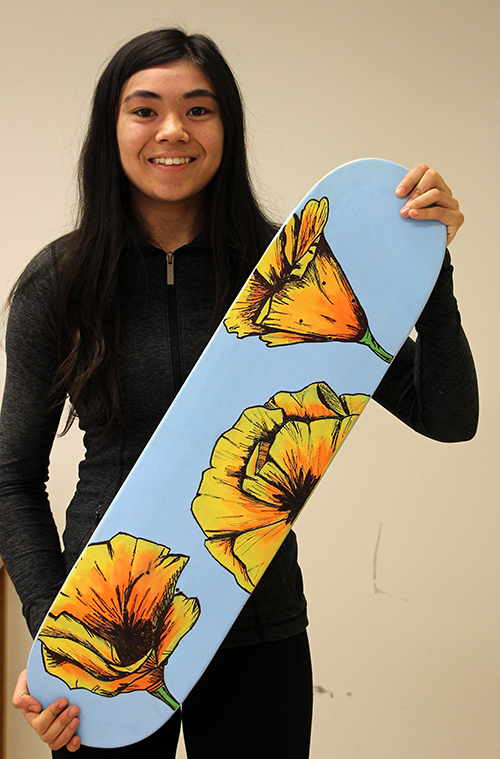 Chloe Kuo: California Golden Poppies on bamboo skateboard “I picked this flower as the subject for my piece, and a skateboard as my medium because both remind me of my hometown (San Diego). Leading up to this final piece, I painted lots of different poppies on canvas, experimenting with style, color, and shape, before deciding on vibrant yellow/orange on a pale blue background, in a semi-realistic/pop-art style.” 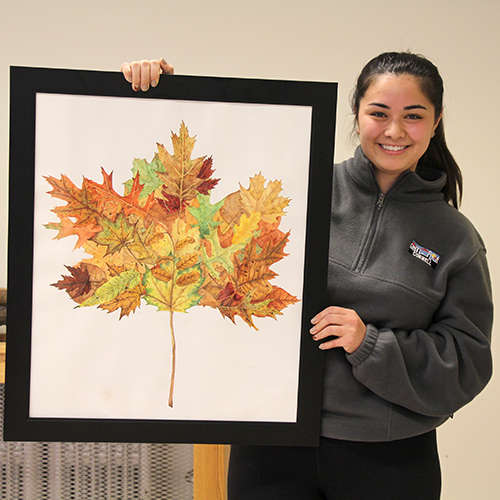 Allie Buccino: Watercolor leaf of leaves “The first leaves I painted were created using real pressed leaves I had collected during the fall. As I continued, I eventually ran out of references so I resorted to making the outlines based on my leaf samples and then just filling them in with different color combinations. I found that by the time I ran out of leaves, I had been closely studying so many different leaves that I could blend colors together to look realistic without a reference.” 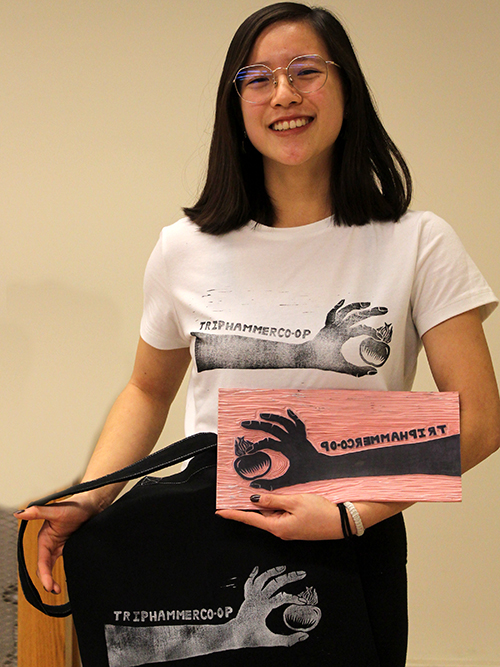 Lok Yee Jacqueline Wong: Block printed design of locally bred tomato and housing co-op “My final product is the carving block of a hand holding "Veronika #3", a tomato breed that was grown and crossed on the front porch of my housing cooperative. While I used it to print my design on a t-shirt and canvas bag, the overarching project was an interactive experience that engaged 17 other people. Specifically, I hosted a workshop to teach block printing on paper, t-shirts, tote bags and other items.” 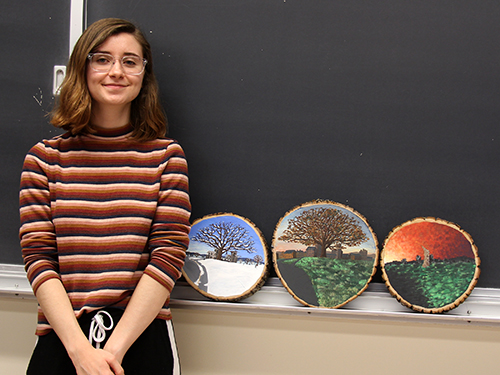 Rachel Nash: Acrylic paintings on basswood of the Past, Present, and Future of oldest tree on campus “This project was inspired by my love for the oldest tree on our campus and a desire to symbollically represent a warning about climate change. It can also be interpreted as hopeful because of the resilience of nature. A variety of tools are used to represent the passing of time, such as West Campus’s changing architecture, a deepening sunset, warming seasons, and progressively looser and more textured painting styles which reflect increased chaos/destruction.” 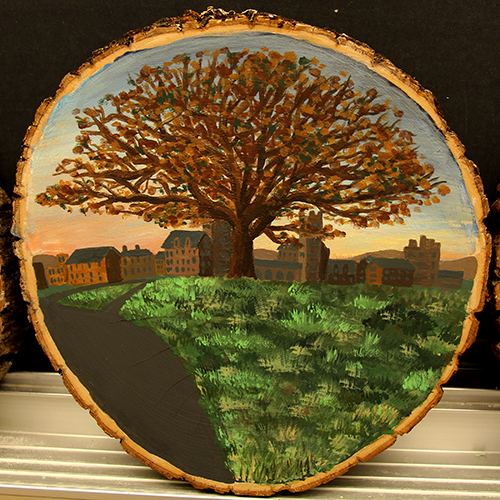 Close-up of one of Nash's paintings 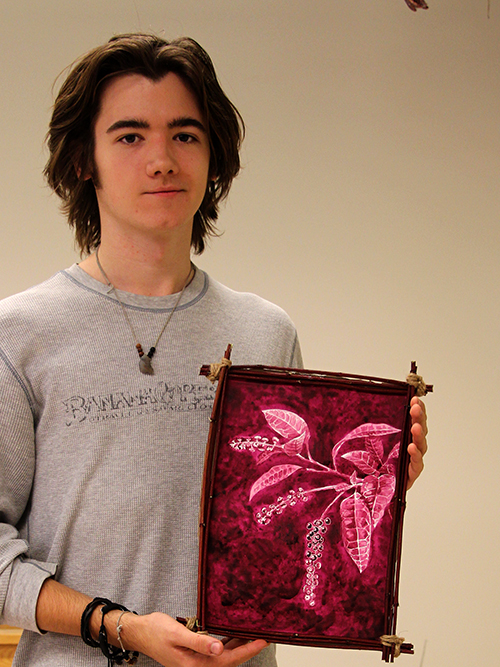 Marcus Saldarriaga-Grote: Portrait of Pokeberry (Phytolacca americana) in stages of maturation with Pokeberry pigment “I've recently had a fascination with coloring with natural pigments. There are many native plants in Ithaca that produce berries with very strong pigments such as wild grapes (which I have painted with before) and pokeberries. The ink was made by crushing mature berries and mixing with vinegar and salt. Many layers are used to achieve the dark colors and lighter ones are from diluting with water. The frame is made with dogwood shoots growing off of mature branches, dried out and tied together at the ends with jute twine.” 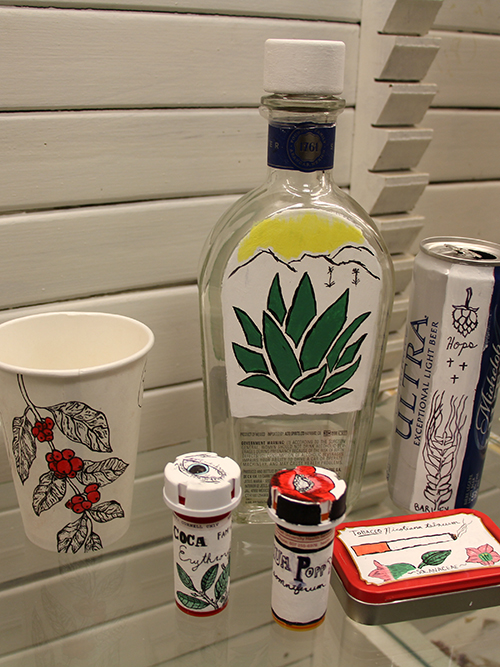 Amy Curlew: Botanical illustrations of the plants behind the compounds “I have encountered a plethora of circumstances that I have no control over, each situation having a common variable, addiction. This made me think further about addiction within my own life. I have numerous family members and friends who have succumbed to the addictive properties of cigarettes, alcohol, drugs (recreational or prescribed) or innocently enough coffee. To connect this to horticulture, I thought I would depict a story on each packaging of those drugs. I will provide facts and information about each of the plants necessary in the formation of the substance that alters the chemistry of a person's brain.” 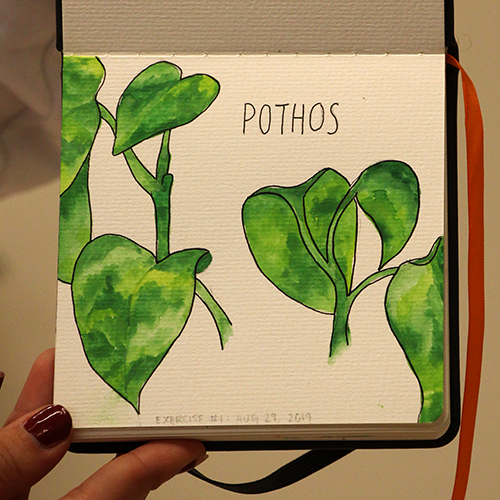 Lillie Seigle: Watercolor journal depicting plant propagation experiments “I was able to show a lot of what I’ve accomplished in the (propagation) class, but there’s also room for me to continue painting and recording the progress of my plants. I’m definitely planning on writing up notes about all the experiments once they’ve all completed on the pages opposite their paintings. Overall, I think this project turned out to be even better than I thought it was going to be because I was able to bridge two of my classes together and get more out of both.” 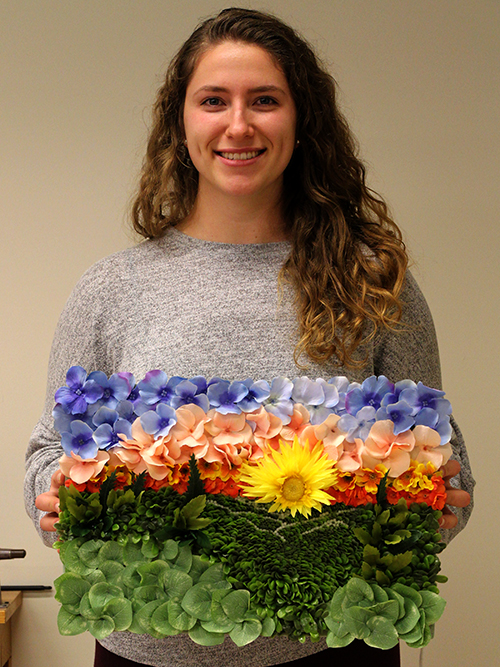 Victoria Zataveski: Landscape in Flowers based on Photograph of Sunrise “This whole process of creating an image with fake flowers has really made me want to try to do the same with live flowers in the future. I am curious to see if the end product would be similar or different. Although I have done many floral arrangements before, this is the first time I have ever used a foam flower arrangement board and I really liked it and will definitely use it again to make new arrangements.” 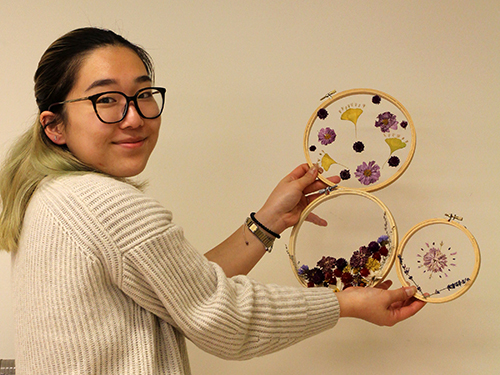 Jessica Lee: Four floral arrangements in tulle framed in embroidery hoops “I learned so much and became a lot more observant of nature all around me because during this project I would notice flowers and plants around me as I walked outside. I would think to myself, 'how would this plant work?' 'Would I want to use this?' 'I wonder how this plant will dry' or 'Wow I’d love to capture that color in my work.' Overall, I had so much fun learning about flowers and the flower drying process while also learning to the appreciate all the unexpected aspects about the creative process and nature.” 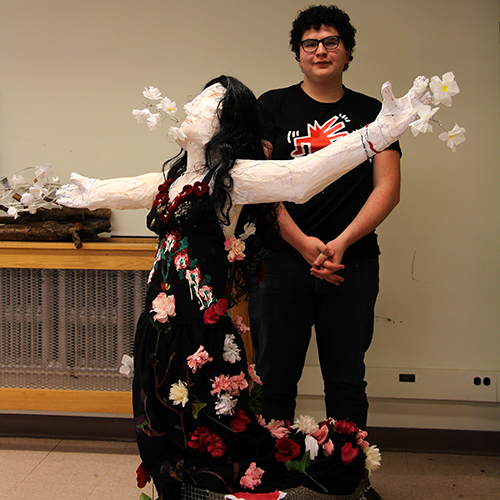 Octavio Martin: Wire and papier-mâché sculpture in tribute to character Dina of The Band’s Visit “It is meant to capture a specific moment of cathartic release due to vulnerability...The statue is meant to show that letting go of fear and baggage and that joy and almost elevated feeling of it… Jasmine flowers are used to symbolized things like love and beauty and romance and motherhood in different places, and they’re all complex things that exist at our core that with vulnerability people show them. It takes a lot of energy for plants to grow flowers and they’re very fragile parts of plants and put them at risk, and it's all for a chance to spread and survive and find each other.” 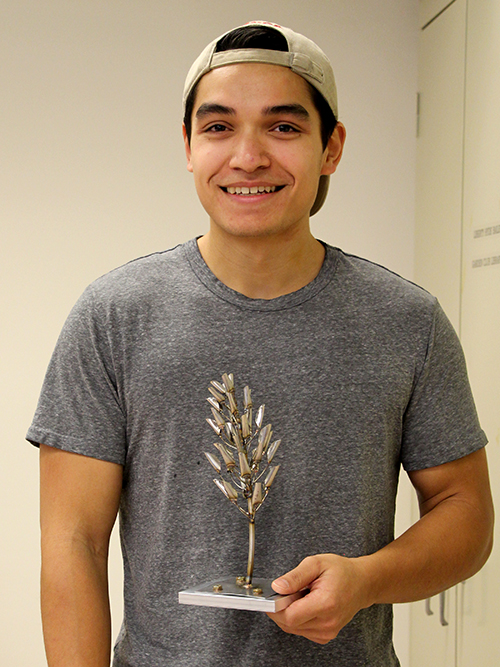 Joseph Benjamin: Welded stainless-steel Lupine (Lupinus sp.) “All the metalworking, welding, machining, and ideation was done by myself, which lead to a very personally pleasing product. Overall this project took me probably 30 hours of metalworking, but because the process of working with my hands is so enjoyable to me, I found no trouble making that happen once my schedule afforded me the time.” 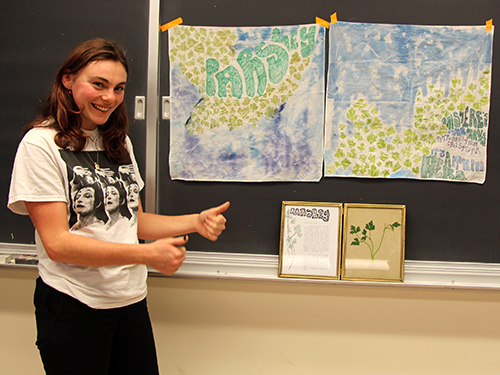 Maisie Oswald: Cyanotype and pounded parsley on cotton with haiku “I loved working with the parsley and creating a narrative around the materials I used. This piece is more about the process than the finished product. I really wanted to include writing into the piece, which I did through the haiku on the fabric itself as well as with the little framed statement. I hope to have it for a long time--I cannot wait for it to fade and age with the years.” 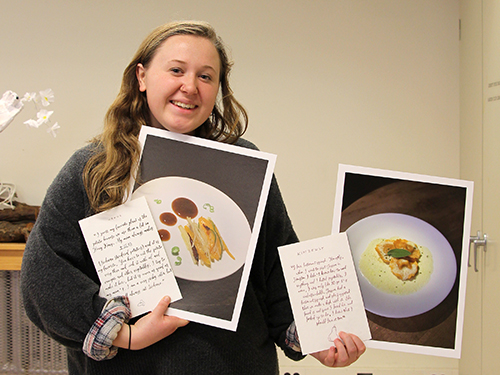 Lydia Caroe: “Feast from the Field” in three forms: literary (written word stories), culinary (original dishes, plated as art), and visual (professional photography of staged dishes) “My final piece is an exploration about how personal narratives about humans and their interaction with plants can inspire art. The center of the piece is a five course tasting menu in which each dish is inspired by a story that an individual shared with me about a plant that was influential in their life. This project was such a delight and I learned the practical skill of aesthetic plating design as well as further developed my philosophy about how life-giving the interaction between plants and humans is.” 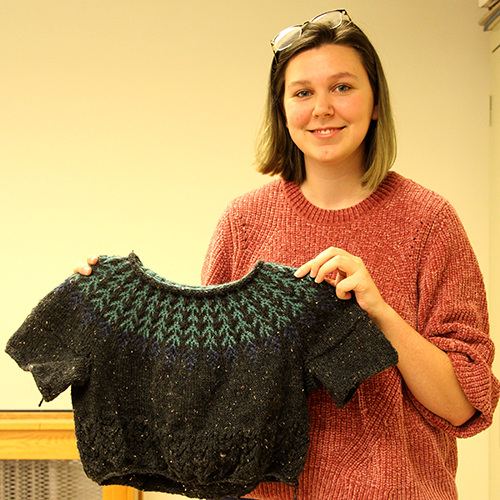 Audrey Rytting: Knit sweater with botanical motif “The flowers in the motif at the neckline are bluebonnets, the state flower of Texas, where I grew up. They remind me of home - they grew throughout my backyard, along the path on my way to school, and in the fields behind my home. This was the first sweater I have ever attempted to knit, and it gave me a new appreciation for the amount of time it takes to create something like this.” 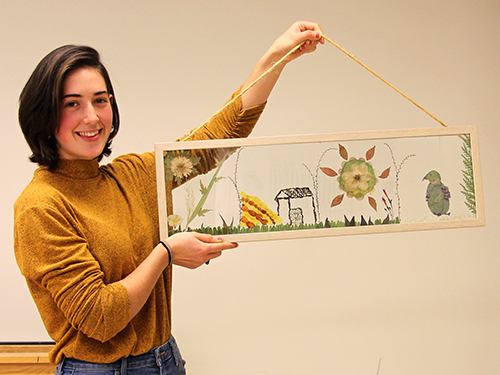 Anna Ullmann: Window hanging of pressed plants in glass to represent the four seasons “I created a window hanging out of pressed leaves and flowers primarily from the Botanic Gardens but supplemented with species found on campus and in front of my parents’ house for added sentimental value. There is also a small document accompanying the work, listing the identified species according to their respective seasons. This single frame is split into four sections, each representing a different season. Each plant species was chosen for its respective season according to budding time and color. Additionally, each season is designed using a different artistic method. Spring depicts a landscape, summer shows as agriculture farm, fall is a mandala, and winter is a mosaic penguin.” 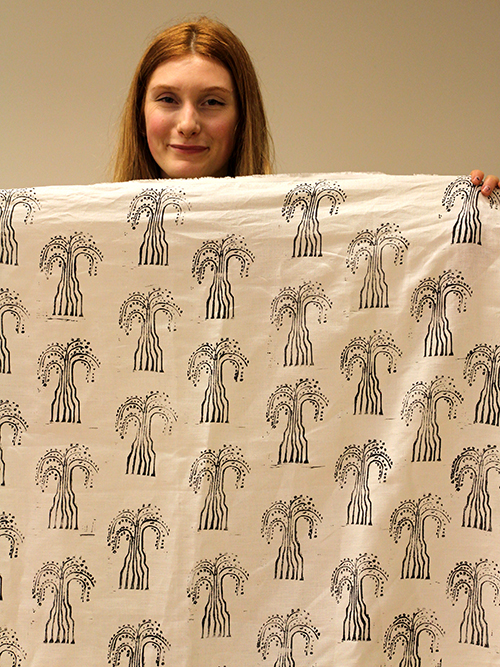 Sage Taber: Block printed willows on linen “I loved creating my block print pattern, Salix, and think I am hooked! Working with linen fabric was a lot of fun and I fell in love with the materiality of it. My head has been so immersed in technical research this semester, and this course was the freedom away from it that I was looking for. I learned a lot about carving for my final project and can’t wait to continue with it.” 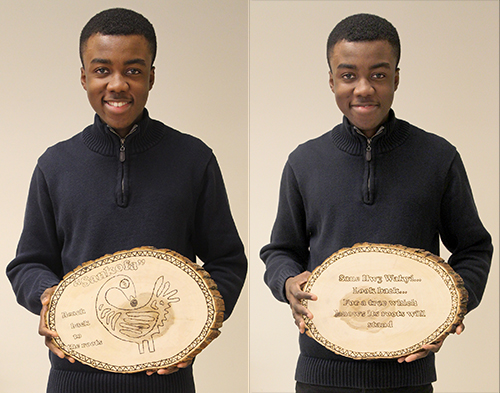 Prince Osei Marfo: Sankofa symbol and poem wood burned into basswood “I have been able to appreciate how plant materials like wood, leaves and flowers are not only objects which can be admired artistically but are also materials through which art could be created from. In my final creative project, I would like to put this lesson into practice by creating culturally inspired art from plant materials. Sankofa is an African folklore symbol which represents the act of revisiting one’s roots. I believe this symbol is relevant to this course because many people have lost their rudimentary connection to mother nature, a connection which I believe should be part of us all.” 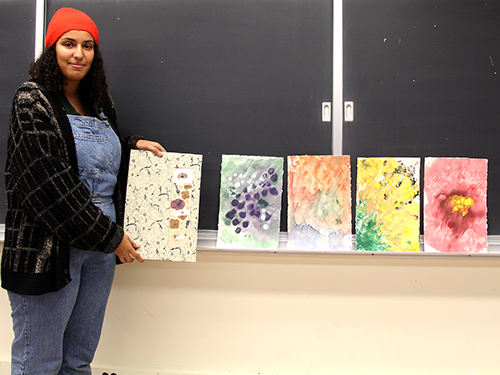 Lauren Williams: Handmade clamshell book with 8 prints and photographs based on seasons “Each season has a colorful abstract print and a black and white photograph based on a plant I associate with that season. It poses a drastic juxtaposition of shape, texture, color and medium to show an emotional and curated view of each plant. The pieces arranged by the growing season starting in the spring with a peony and kousa dogwood blossom. Summer shows a sunflower and a giant lotus seedpod, with fall having roses and Chinese silver grass. Winter is finished up with Japanese beauty berry and snow covered dried hydrangea. I am honestly so pleased with how it turned out.” 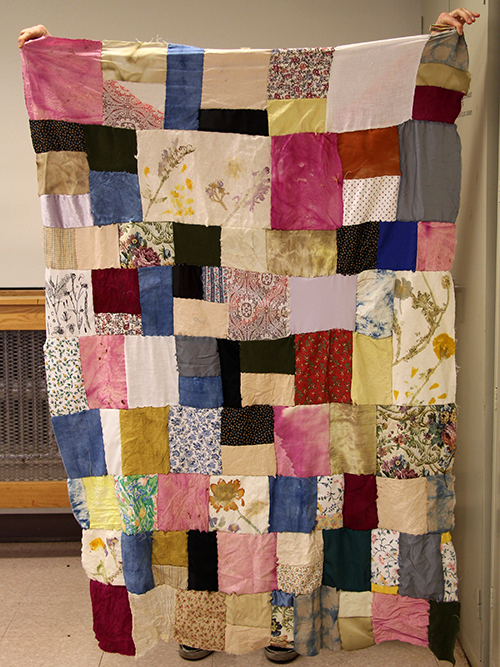 Ashley Carmalinghi: Quilted fabrics dyed and pounded with plants “This quilted curtain was a practice in patience, not one of my strong suits. Though I have quilted before, I have never done so with such a variety of materials.... I learned how to dye fabric, how to weave, and how to pound flowers.” 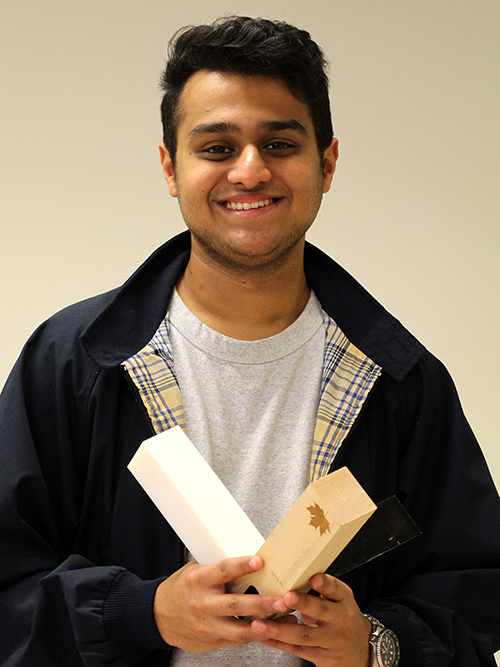 Vignesh Gnanasekaran: Sculpture in Three Parts “The first part is CNCed maple wood, with a maple leaf laser engraved on it, the second part is molded urethane rubber with embedded dried leaves, and the third part is a 3D printed polymer piece with a futuristic tree depicted on it. My intentions while making this sculpture was to depict a range of raw materials, from entirely natural (unfinished wood) to naturally derived (rubber) to entirely synthetic (proprietary UV-cured polymers), showing harmony among discordant themes. Additionally, the plant matter depicted on the parts range from natural (the maple leaf) to futuristic (the circuit).” 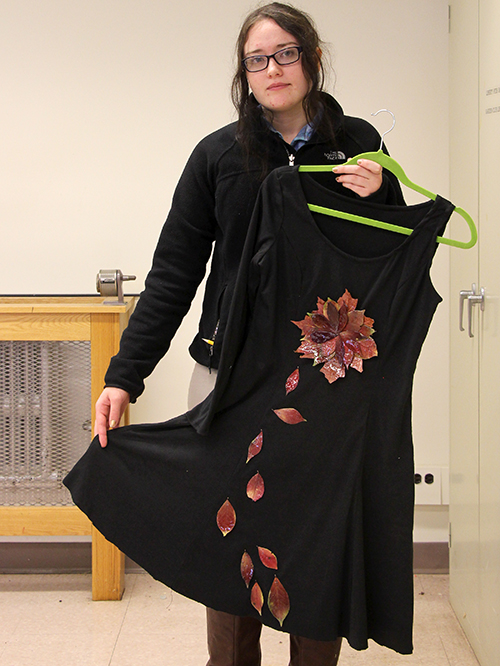 Eliza Fisher: Handmade dress and hair clip with preserved leaves “To preserve the leaves I pressed and dried them and then coated them in liquid rubber to give them enough strength to not shatter. Originally I had wanted to cover the whole dress but that would have been heavy, increased risk of breakage, and as I started putting the leaves on the dress I found I preferred a more minimal design… The dress I made using a cotton based knit fabric, I liked the idea of having it one sleeved to further reflect the idea of leaves falling and leaving bare trees as the season progresses.” 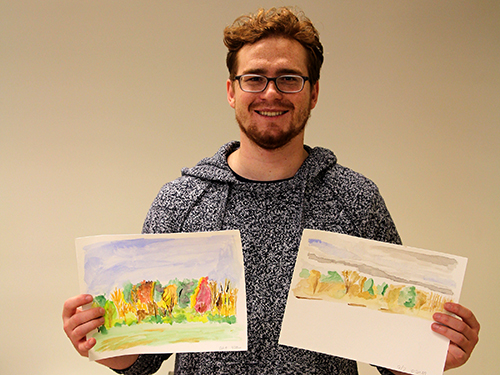 Philip Greenwood: “A Brisk November” “This is an eight-week watercolor study from mid October to early December of a landscape near my apartment complex. The goal was to capture the changing of the seasons from fall to winter as well as to begin my journey in using watercolor paints.” 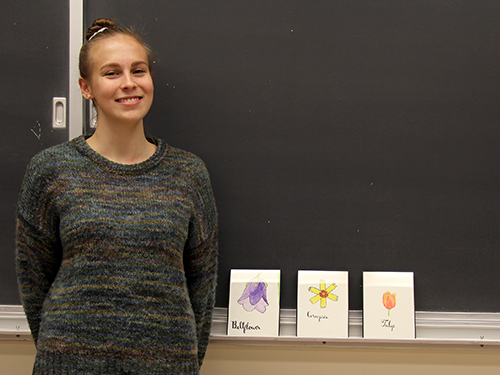 Whitney Wright: Flower portraits for each family member “I will dedicate one to my mother, one to my father, and one to my grandmother. Orange tulips symbolize gratitude, so I figured my grandma would appreciate that considering she had an enormous impact on my young adult life. With each painting I’m thinking about practicing my calligraphy skill.” 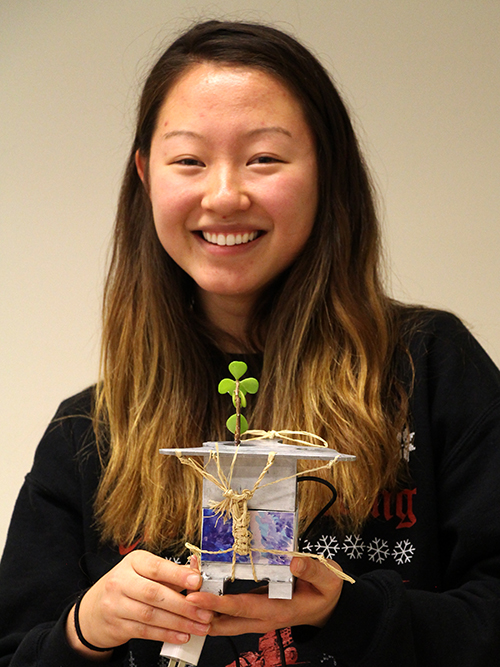 Alexandra Siskovic:”Al Ovata” (Aluminum, Rejoice!) hydroponic house plant “The frame is 6061 aluminum scrap that I found in a bin of recycled metal. The internal components of the piece include a small aquarium pump to keep the water from going stagnant, with some epsom salts and water. Using what I learned from our natural fibers class, I decided to use raffia twine to constrain the top lid. I thoroughly enjoyed watercolor painting, so I included some small works that I made in between study breaks.” 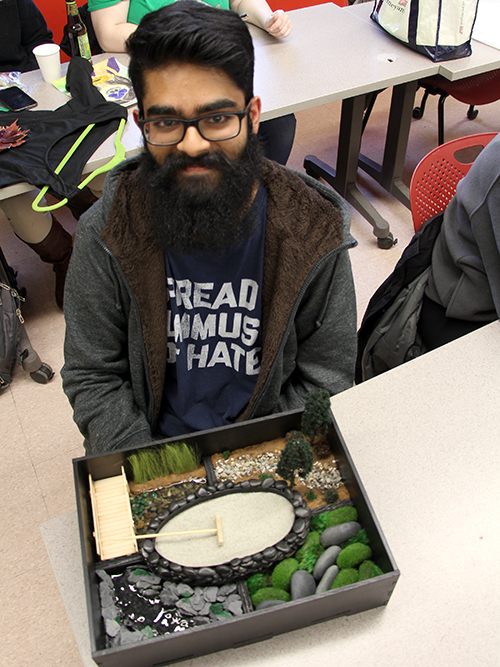 Yamaan Atiq: Minature Zen Garden inspired by Cornell landscape “I learned to look up and appreciate my surroundings, and become more observant and look at the details of the natural world. Since each scene was modeled and inspired by locations around Cornell, I had to become more receptive to what makes a forest walkway a forest walkway, or what makes a gorge a gorge. I’m really happy with how interactive and inviting it is for people.”
|
||||